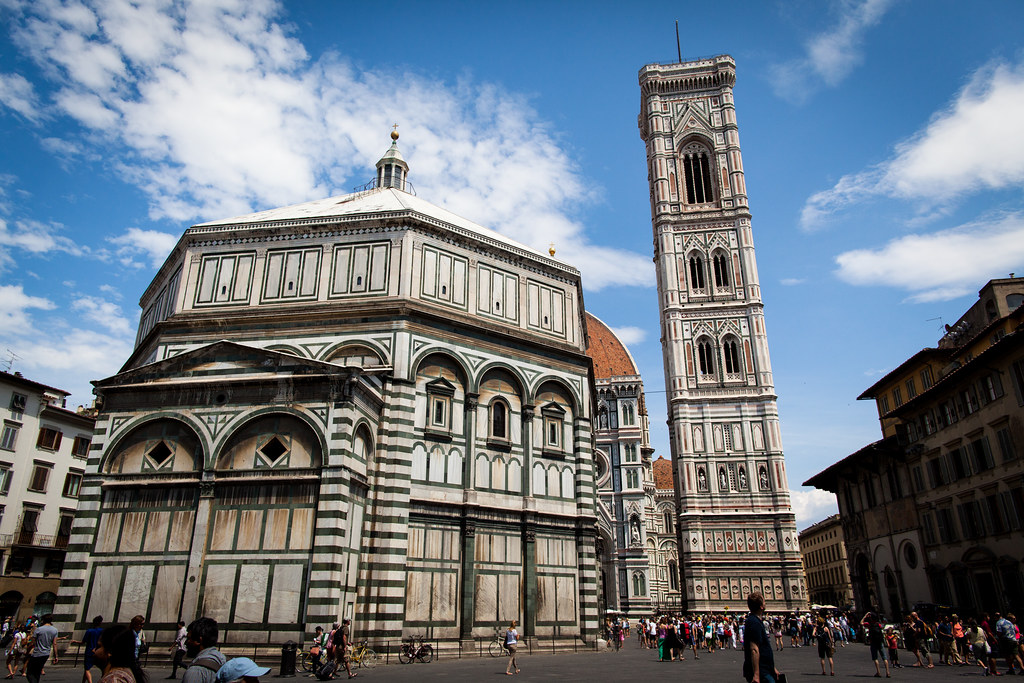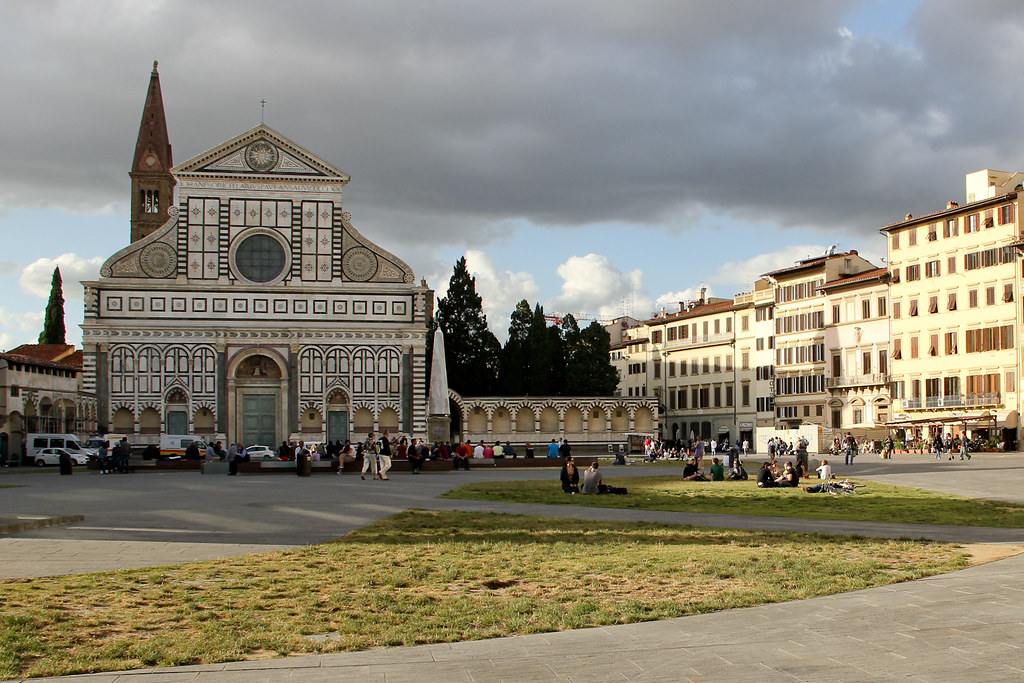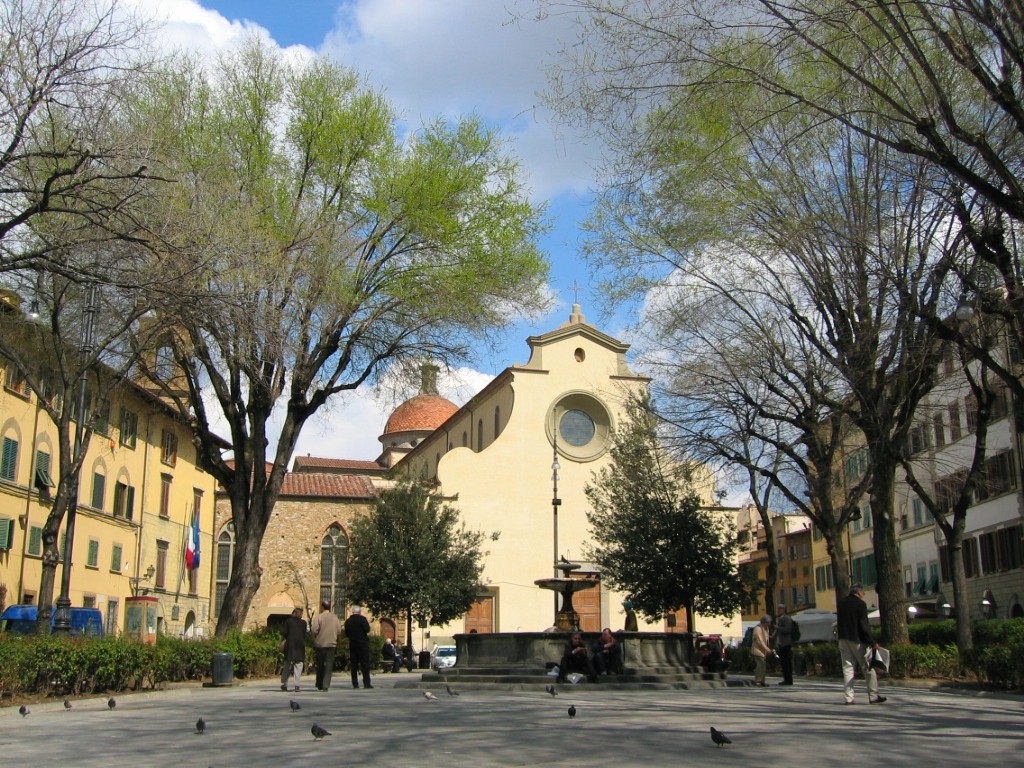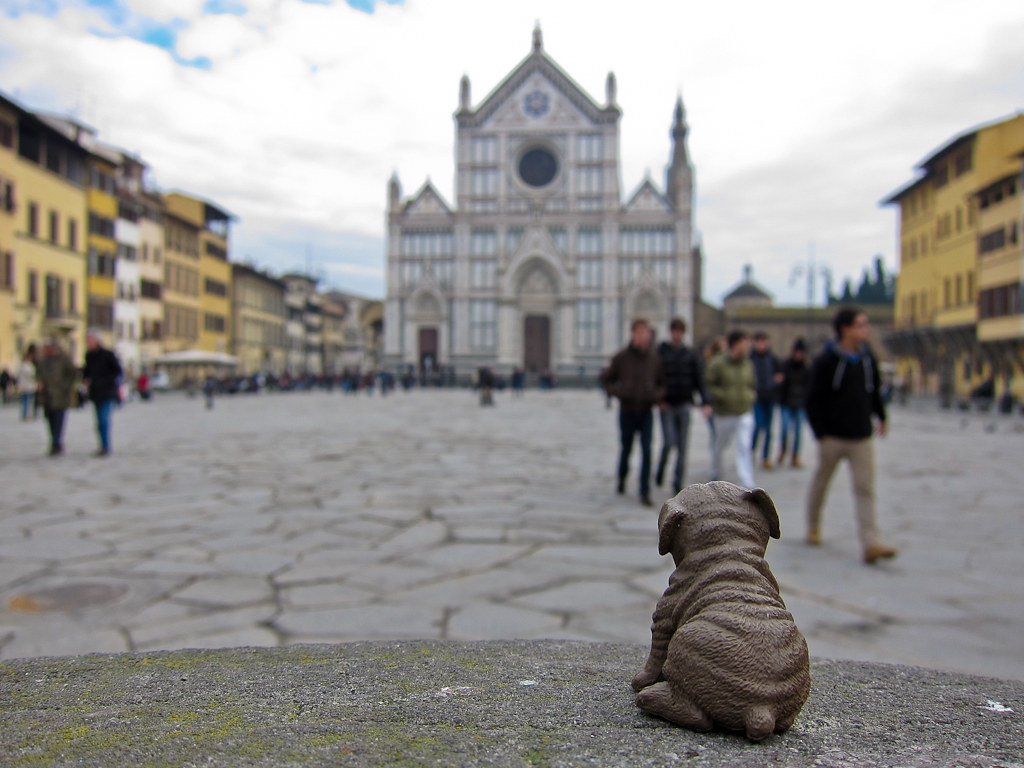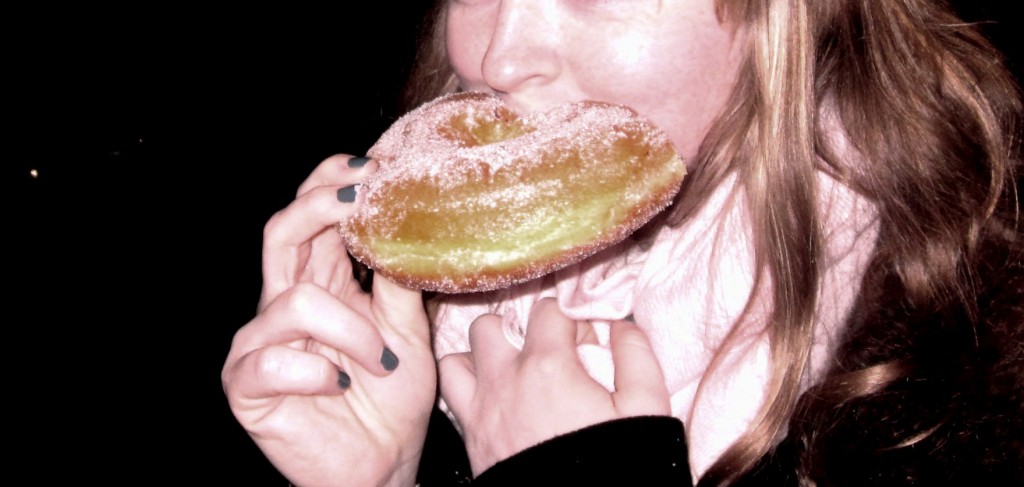One week every June, the city of Florence draws lines in the sand. Suddenly the people are no longer Florentines, but Bianchi (Whites from the Santo Spirito quarter), Azzuri (Blues from Santo Croce), Rossi (Red from Santa Maria Novella), and Verdi (Greens from San Giovanni). Throughout the week, the city convenes in Piazza Santa Croce to watch the single elimination tournament of a game that can only be described as the love child of rugby and gladiator battles. It’s called Calcio Storico, and for the month of June, it defines the city. During this week, neighborhood pride escalates to dangerous levels. The tournament that has been battled out for over 500 years has resulted in many injuries and even deaths, both in and out of the arena. So how will you possibly decide which color you will sport come the fourth week of June? A little exploring, of course!
San Giovanni is the pulsing, beating heart of Florence. Some may say it has an unfair advantage, as it gets to claim the axis of the city and the religious center, Piazza del Duomo. On the flip side, 90% of all tourist activity in Florence will take place in this neighborhood, tarnishing our shiny, fuzzy, warm fantasies about quaint Italy. But I’ll let you decide. The biggies of this neighborhood include:
- Duomo Complex, Piazza del Duomo: The home to Brunelleschi’s dome, Giotto’s Campanile, the Florence Cathedral (Santa Maria del Fiore), and the Duomo museum, Piazza del Duomo has the potential to absolutely drain you and fry your quads. So pick a few that interest you the most–don’t try to do it all. The rest of San Giovanni awaits!
- The Accademia, Via Ricasoli 60: Where David, THE DAVID, lives.
- San Marco, Piazza San Marco: A monastery decorated with an incredible and exhausting series of Renaissance Master Fra Angelico’s paintings.
- Piazza Santissima Annunziata: Home to the Ospedali degli Innocenti, one of Brunelleschi’s first works.
- The Palazzo Medici Riccardi, Via Cavour 3: Where the real power behind Florence lived as clandestine puppeteers before taking over the Dukedom.
- San Lorenzo, Piazza San Lorenzo: The behemoth church that is essentially one massive ode to the Medici, the family that founded the Renaissance, and boy, does it have the art to prove it!
Eat
It is easy to get sucked into tourist traps in San Giovanni. However, if you are tactful in your choices, you can find some of Florence’s most authentic food right under your nose. Both located near San Lorenzo Market, I personally recommend:
- Trattoria Mario, Via Rosina 2: It is located just behind the market, and offers one of the most local experiences you can have for lunch. Prices are remarkably reasonable, food is authentic Tuscan, and locals love it!
- Da Nerbone, San Lorenzo Market. Inside the market itself this small eatery. If you are courageous enough to try Florentine specialty, Lampredotta (cow stomach), this is your place. If you can stomach this stomach (I can’t), I hear it is the best!
Shopping
- San Lorenzo Leather Market: You can do more than barter your way to your next leather jacket here, though you will find tradesmen with scarves, pottery, purses and every souvenir your heart could desire (my favorites are the David aprons that make you look naked–they just never get old).
Favorite Hidden Gem:
- Il Chiostro dello Scalzo, Via Cavour 69: Don’t blink, or you’ll miss the slightly ajar door on Via Cavour just past Piazza San Marco. If you happen to stumble upon this pocket-sized cloister during opening hours, indulge in an off color artistic experience.
The neighborhood of Santa Maria Novella spans a wide swatch of Florence, claiming both the hectic and eclectic transportation hub, as well as the very posh and tailored Via Tornabuon. With a variety of sights, there is a unique travel experience awaiting everyone in Santa Maria Novella. My top hit-list includes:
- Basilica of Santa Maria Novella: Beacon of Renaissance Art in the city. The adjoining museum provides access to the captivating Spanish Chapel for only a few euro.
- Pharmacy of Santa Maria Novella, Via della Scal 16: The world’s first pharmacy. Founded by the Dominican friars of Santa Maria Novella, the pharmacy is now a luxury perfumeria.
- Palazzo Strozzi, Piazza Strozzi: A Renaissance Palace that now hosts rotating art exhibits, free shows and concerts in its courtyard.
- Palazzo Davanzati, Via Porta Rossa 13: For only two euro, explore the last preserved townhome from medieval Florence, furnishings and all.
- The Church of Santa Trinita, Via Tornabuoni: Teeming with must-see art.
- Piazza della Repubblica: A fashionable piazza built in the 19th century, when Florence was the capital of Italy.
Eat
- Caffe Gilli, Piazza della Repubblica: Gilli offers a fashionable, chic café experience. Delightful pastries artfully displayed in the windows will, of course, lure you in. Take a seat, and perhaps feel a rush of inspiration. Many say this is where the Futurist movement began.
Shopping
- Via Tornabuoni: Lucky for you and not your bank account, Santa Maria Novella claims Via Tornabuoni–the high fashion drag of the city. In a fashion capital such as Florence, you can expect great things on this strada. Hometown designers such as Roberto Cavalli, Salvatore Feragamo and Guccio Gucci are headliners, followed closely by Dolce & Gabanna, Louis Vuitton, and Pucci. If your bank account can’t swallow a $2,000 purse, pop over to some more budget-friendly stores around the corner, such as Zara, H&M and Rinascente.
Favorite Hidden Gem:
- Carousel, Piazza della Repubbilca: This carousel is perhaps the most charming ornament of the city. After spending an afternoon window shopping, cappuccino sipping and art perusing, there is perhaps no better whimsical cap to your fantasy day in Santa Maria Novella than a €1.50 whirl on the carousel.
Santo Spirito, the Whites
Just across the Arno River from the neighborhood of Santa Maria Novella is Santo Spirito. Love them or hate them, hipsters know where to go for true authentic art, antiques and eats. And the neighborhood of Santo Spirito is where they head for all it all.
Sights in the neighborhood are priceless. On your hit list, please add:
- The Brancacci Chapel, Piazza del Carmine: Birthplace of Renaissance art? I’ll let you be the judge.
- Palazzo Pitti: This is what you get when the ruling family and founders of the Renaissance (the Medici) cash in for an upgrade. The palace now houses staggering art collections, a costume gallery, and access to…
- The Boboli Gardens: Pitti’s backyard. Trust me, you’ll want to play.
- Bardini Gardens, Costa San Giorgio 2: For more flora, fauna, and remarkable views of Florence, check out the Bardini Gardens. Significantly thinner crowds than its popular big brother, Boboli, Bardini offers a truly relaxing afternoon.
Eat
- Gusta Pizza and Gustapanino, Via Maggio near Piazza Santo Spirito: Owned by a rowdy bunch of boys from Naples, these cooks know exactly how to spice up the Florentines.
- Trattoria la Casalinga, Via de Michelozzi 9r: A true Italian family-style dining experience. Reservations are not accepted, and tables are limited. Arrive right at 7:30 to land a table for the night. Prices are excellent!
- Osteria del Cinghiale Bianco, Borgo San Iacopo 43: Since you’re in wild boar country, it’s time you try some!
- Trattoria 4 Leoni, Piazza della Passera: Pear pasta, bistecca alla fiorentina and Florentine cheesecake. Cue mouthwatering now.
- Gelateria Ponte Carraia, Ponte Carraia: My personal favorite gelato in the city. Metal bins = made in house (good rule to live by in Italy).
Shop
- Santo Spirito Markets are full of treasures. We suggest the antique market on the second Sunday of the month for true scavenging for treasures. Vintage and antique shopping is highlighted in this district. It’s also a good place to check out artists’ studios for some original pieces to take home with you.
Favorite Hidden Gem:
- The Capponi Chapel, Piazza Santa Felicita: This little treasure chest is essentially one big Manneristic magic eye. I recommend dropping some coins in the box to illuminate the space.
Santa Croce, the Blues
Hopping back over the Arno once more lies the quarter of Santa Croce. While San Giovanni claims the religious heart of the city, civic goes to Santa Croce by its claim over the Palazzo Vecchio and Piazza della Signoria. This neighborhood is unfamiliar with the concept of peace and quiet, and its attractions draw locals, students and tourists alike at all hours of the day.
While you’re at it, see:
- Basilica of Santa Croce: Often called the Pantheon of Florence, this is where everyone who was anyone is laid to rest (we’re talkin’ Michelangelo, Galileo, and Machiavelli, just to name a few). The adjoining museum give s peek into the basilica’s colorful past.
- Piazza della Signoria: The political heartbeat of Florence, this piazza is the playing field for 500 years of political propaganda.
- The Uffizi Gallery: The most renowned art museum in Florence, and arguably, the entire world. (easy there Louvre fans)
- The Bargello, Via del Proconsolo 4: The Bargello is a former prison turned art museum, whose structure is almost as magnificent as the art it houses.
- Galileo Museum, Piazza de Giudici 1: Relive the story of the the man himself. AND see his middle finger – they have it.
Eat
Busy sightseeing, I’ve found that my favorite eateries in this neighborhood are gelaterias and sandwich shops.
- Gelateria dei Neri, Via dei Neri 26r: Hands-down, the best gelato in Florence. Fight me on this, I dare you!
- All’Antico Vinaio, Via dei Neri 74: An authentic sandwich shop just down the road. It delivers a delicious meal for only a couple euro.
Shop
- Leather : You are in the leather district of Florence – I recommend indulging. Leather shops line the streets. Even the Basillica of Santa Croce has its own leather school and shop, which is connected to the Santa Croce leather school. You can tour for free during opening hours!
So…again, which color will you be sporting this June in Florence?

